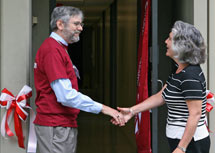
Handy Links
SLAC News Center
SLAC Today
- Subscribe
- Archives: Feb 2006-May 20, 2011
- Archives: May 23, 2011 and later
- Submit Feedback or Story Ideas
- About SLAC Today
SLAC News
Lab News
- Interactions
- Lightsources.org
- ILC NewsLine
- Int'l Science Grid This Week
- Fermilab Today
- Berkeley Lab News
- @brookhaven TODAY
- DOE Pulse
- CERN Courier
- DESY inForm
- US / LHC
SLAC Links
- Emergency
- Safety
- Policy Repository
- Site Entry Form

- Site Maps
- M & O Review
- Computing Status & Calendar
- SLAC Colloquium
- SLACspeak
- SLACspace
- SLAC Logo
- Café Menu
- Flea Market
- Web E-mail
- Marguerite Shuttle
- Discount Commuter Passes
-
Award Reporting Form
- SPIRES
- SciDoc
- Activity Groups
- Library
Stanford
Around the Bay
PULSE Moves In
The PULSE Institute for Ultrafast Energy Science has a new home at SLAC. This week, the first of several newly renovated offices and laboratories in Building 40 officially opened for PULSE researchers.
"Laboratories evolve, and I think that this space is symbolic of the evolution of SLAC," said Laboratory Director Persis Drell. "Building 40 is one of the original buildings on the site. These labs have been used to build detector elements, to support work for the colliding beam program and to run the materials program. And now this space is serving as the home for a new field: ultrafast science."
The refurbished offices and new laboratories are the first dedicated PULSE space at SLAC. Until now, researchers worked in borrowed laboratories and temporary offices.
"This is a great location for us, showing the centrality of photon science at SLAC," added PULSE Director Phil Bucksbaum. "A lot of people have helped us get here, including the whole Photon Science division, the Facilities Department and specifically the three project managers, David Rich, Jo Beth Folger and David Saenz."
Building 40 is quickly becoming SLAC's photon science hub. Within the next year, additional renovations will expand the PULSE space to three times its current size. Over the next two years, additional offices and a large materials science research lab will also be created in Building 40 for members of the Stanford Institute for Materials and Energy Science.
"All of SLAC's photon science directorate will soon be located within this space," said Photon Science Director Keith Hodgson. "That's important because of the natural interactions that will occur. Even though the people in these offices will be doing different things—X-ray science, materials science, and so on—there's a synergy in people talking to one another."
Both SIMES and PULSE are joint institutes of SLAC and Stanford University, funded by the DOE Office of Basic Energy Sciences. PULSE research focuses on ultrafast dynamics in materials science, the generation of extremely short laser pulses, the imaging of single molecules and non-periodic materials, and the study of ultrafast chemical reactions. SIMES scientists conduct research on combinations of complex and novel materials, seeking to elucidate the structure, behavior and dynamics of materials.
—Kelen Tuttle
SLAC Today, June 18, 2009
